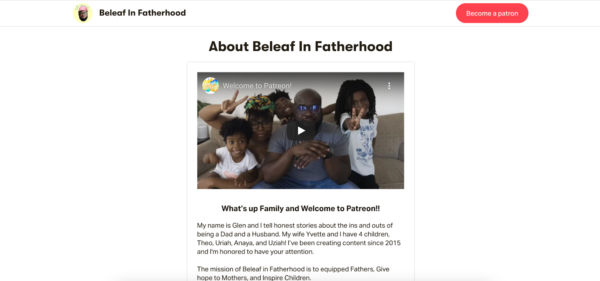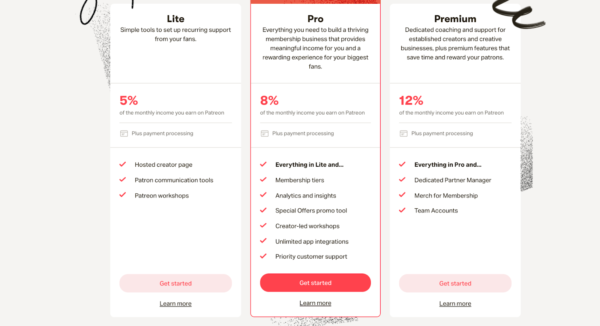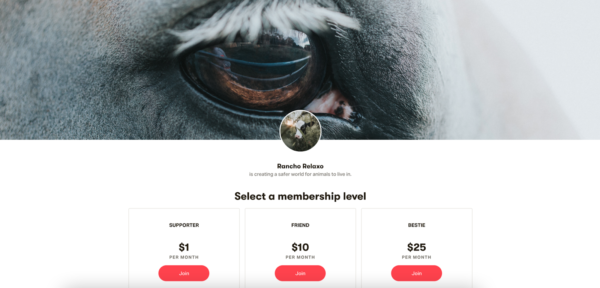Or Log in With Facebook Continue With Facebook New to Patreon Sign Up

As content creation morphs into its own form of business, creators look for ways to stabilize their income. Some look to social media to monetize, others make and sell merchandise (merch). But there's a centuries-old way to focus on creating while making money — patronage. That's where having a Patreon comes into play, and if you're here, you may have heard a little bit about it.
Anyone can use Patreon as a source of revenue. It has no up-front costs, and there are just a few things you need to make it successful. So, should you jump on the trend? In this post, we'll go through everything you want to know about how to start a Patreon — why it was founded, gauging if it's right for you, how it works, and launching your own Patreon campaign.
We make it easy to get your work out to your network and beyond with all the marketing tools you need.
About Patreon
Like many great businesses, Patreon was founded by someone who wanted to solve a problem. Patreon's origin story goes back to when Jack Conte was making videos online. He noticed YouTube monetization was unstable and largely dependent on an algorithm for views. Conte called his Stanford friend Sam Yam and asked for help creating something that could help. The idea alluded to Renaissance-style patronage under which artists could create freely with financial support. They got to work on a platform that allowed creatives to ask for the support they needed. Then in 2013, Patreon was born.
Unlike Kickstarter — which funded large projects in advance with one campaign — Patreon allows creators to make recurring high-quality content in exchange for a monthly donation. Fast forward to 2021 and creators are using Patreon to make all kinds of content with support from their followers. Some are even well-known creators like Issa Rae, who went from making web series to producing the HBO hit "Insecure." So, how exactly are content creators making money to work instead of working to get paid? Let's see what goes on behind the Patreon curtain.
How Patreon works
Patreon lets your followers and fans become your biggest supporters, financially speaking. You might be thinking, "Aren't fans already supporters?" but let's break that down. When you stream a song by your favorite artist, Spotify gives them less than one cent for that stream. Patreon founder, Jack Conte, would get millions of views on a YouTube video, and see only $100. Before Patreon, creators were actually losing money doing what they loved, despite having large audiences.
Now, Patreon cuts out the third parties that take most of your profits. They implemented and proved the theory that if you focus on creating content fans love, those followers will pay for it. This model frees you from third-party limitations that curb your creative freedom and take all your cash.
What does Patreon get in return? Around 5% to 12% of your revenue, depending on the benefits that you want.
Signs that Patreon is right for you
When getting started with digital marketing on a new platform, a lot of questions arise. Like social media, Patreon offers ways to connect with those who follow you, but what if you're concerned supporters will be turned off by a paywall? How do you know if Patreon is worth it for you? Should you just keep developing your content on your own?
Here are some signs that you should hop on Patreon:
- You have an audience. Patreon won't help much in finding new audiences for you, so you have to bring your own or have a growth strategy in place.
- Your content is cost-effective. If you're raising $1,000 a month but need $20,000 to create, Patreon will barely make a dent.
- You need a boost to make better content. Patreon gives you that external motivation every month reminding you that people want to see what you make.
If the above sounds like what you're looking for, start your Patreon page and tell your followers to meet you there. Let's go through how to get started.

How to start a Patreon
Patreon is totally free to start. In fact, if you never get a patron on the platform, you'll never pay a dime. Their job is to manage your community. They're not looking to make money if you aren't either. With the following steps, you can learn how to start a Patreon and launch a campaign:
- Start by registering for an account with an email or online account.
- Next, go through the questions about the type of content you create. Do you make videos? Manage communities? Is your content 18+?
- Choose which currency your patrons will see when they visit. Choose from US dollars, British Pounds, and Euros.
- Connect Patreon to your social media and choose a custom URL.
- Add a high-quality profile photo (at least 256 x 256 pixels) and cover image (1600 x 400 pixels).
- Add a text and video introduction for what your channel is about. Remind people why they're there. Some of your followers may not know what Patreon is.
- Set up your tiers for how much money followers can give every month.
- Set goals for your Patreon. Tell followers your goals (for patrons or monthly revenue) and what you'll do once you reach each goal. For example, once you reach 1,000 patrons, you'll do a live stream Q&A or release a new EP.
Choosing a Patreon plan
Previously, learning how to start a Patreon didn't involve choosing a pricing plan. Patreon only offered support for payment and community management and took 5% of revenue. Then, in June 2020, they launched a Merch for Membership program for all creators. This opened up more options for their pricing structure.

These are the plans currently offered on Patreon:
- The Lite plan (5%) manages your patrons' recurring payments.
- The Pro plan (8%) has everything in Lite plus:
- Tiers
- Analytics
- Special offers
- Workshops
- Unlimited app integrations
- Priority customer support
- The Pro plan + Merch (11%) has all the Pro features and Merch support.
- The Premium plan (12%) has:
- Dedicated partner manager
- Merch for membership
- Team accounts
Choosing which one is right for you will depend on how many patrons you plan to have, how big your organization is, and what you want to offer. If you're unsure, go with the Lite. You can always change this plan later.
Understanding and using the Patreon tier system
When figuring out how to start a Patreon and use their tier system, it can be tricky to define what to ask for. You might find yourself wondering what's too much or what's too little. What can you offer that will be worth that donation? Remember, your fans are there to support you, not to buy from you. Each tier offers an incentive to give (called benefits) not a product.
Patreon tiers are made so patrons can choose what they're capable of giving every month, not how much the benefit is worth. While perks are great, they're not the main reason why fans become patrons. Not every tier has to give a long piece of content or merch. The first one or two can just give access to your Patreon community and exclusive updates.
If you're just starting out, try offering one to three tiers for your fans to choose from. The first can be anywhere from $1 to $3, the second $3 to $6, and the third about $10. As you grow your Patreon, add more tiers for people that want to give a higher amount. You'll be surprised how many people will want to give more if given the chance.
What to offer as benefits
To reward your patrons for their ongoing support, you may want to offer them benefits. There are a few go-to options for patron benefits that creators love. Among these, you'll find:
- Early access
- Physical rewards (like Patreon's merch)
- Votes on future content
- Recognition (a mention in your newsletter or video)
You can get creative with what you offer. If you do coaching or consulting, create a large tier that gives a limited number of fans a monthly session as a benefit. If you're an artist, give them a digital download for the first tier or two. If you're a community leader, Patreon has a full list of ideas of benefits you can offer, including courses.
If you have a Pro plan + Merch or a Premium plan, you can choose what merchandise you want to offer and what designs you want to use. You can decide whether you want to ship the merchandise after three payments or every three months. Patreon will tell you what it will cost you per item to give you an idea of what tier you can attach that reward to.

Setting goals on Patreon
When visitors see your page on Patreon they can see your tiers and your goal(s). For those learning how to start a Patreon, this can be confusing. We've gone through what the tiers are and how to use them, but how does this differ from your goals?
Goals on Patreon can be either how many patrons you want to reach or how much you want in monthly earnings. You can set several goals and attach events to them. For instance, you can set your first goal as $50 and announce that once you reach it, you'll do a giveaway or have a special guest on your podcast. These goals incentivize new patrons to join and help you succeed. As you achieve them, you can set new ones to keep you and your community going.
Types of content to post on Patreon
Patreon is all about making your supporters feel special. For creators, this can mean sharing bonus content and giving early access to upcoming work. What type of content falls under these categories? Here are some examples.
Behind-the-scenes content
Share what it's like to run your organization or business. For example, maybe you make family content on YouTube like Beleaf in Fatherhood. People have connected with your story so much and the growth of your channel that they're invested in you. Sharing behind-the-scenes content allows them to know and see more. Don't underestimate how much people appreciate that. Beleaf gathered almost 800 patrons giving anywhere from $5 to $100 per month.
Bloopers
Most work shared online has been edited and curated carefully to look and sound perfect. But what about the tongue-tied moments and comical goings-on that didn't make it to the finished product? Use your Patreon to share those moments and give your audience a laugh.
First look at new work
Writers who have created a following often share upcoming work chapter-by-chapter on Patreon. In fact, many writers have asked their supporters to help them quit their full-time job. That's the case for science fiction writer N.K. Jemisin. She has a community of almost 1,500 supporters with whom she shares daily updates and exclusive fiction, like side stories of the characters they love.
Bonus episodes
Podcast creators have also benefited from sharing content on Patreon. If you're considering podcasting as part of your marketing, you could use Patreon to give your listenership additional content. If listeners are tuning in to your show every week, they'll be happy to have an extra episode to listen to as well.
Exclusive blog posts
On Patreon, it's common to share blog posts and updates that your supporters want to see. For example, the nonprofit animal rescue Rancho Relaxo updates often with exciting news. Their supporter-exclusive posts tell stories of recently-arrived rescues to reconnect fans with why they donate in the first place.
So, how to start a Patreon is out of the way. Now you need to drive traffic to it. Given that you probably have a following already, consider using marketing tools for this purpose. Here are some options to do that:
Create a landing page
Gather the people that love your content but aren't sure about supporting you right now. Send them to a landing page that tells them all the benefits they get from what you do and how much work you put into it. You can either ask them to convert right away (request that they turn into patrons) or ask for their email instead. With an email, you'll be able to send free content to their inbox and connect with them more. At the bottom of every email, you can add a call to action (CTA) to access patron-only content on Patreon.
Remind current fans via email
If you already have a list of your fans' emails to update them on the goings-on of your work, consider using an email marketing tool like Constant Contact to keep in touch. Like we mentioned above, you'll then have the option to drive traffic to your Patreon with every email sent. Create "fear of missing out" by talking about all the extra content patrons get, share photos of merchandise, if you have it, and how the Patreon community gets more connection with you.
Social media is likely one of the most effective ways you get new fans. Now, it can also be one of the easiest ways to get new patrons. Share your Patreon page on your social media or use paid social media marketing options to get more awareness.
If you need help, use tools that allow you to build your social media presence and automate posting.
Start by asking
With this guide, you have everything you need to know about how to start a Patreon. You've learned what it's about, what kind of creator it's for, and the services it offers. You've even learned a little bit of the backstory of how it all started and developments it's had over time, like the possibility to offer merch and change your pricing plan.
If you're curious about whether your community would be on board with Patreon, start a conversation with them. After all, this is something you'll be embarking on together. See what they know about Patreon and what kind of content they'd like to see there. Consider running polls or surveys on your social media to get an idea of what to create for your launch. Once you've decided, you're all set with the information you need to get started. Happy creating!
Source: https://www.constantcontact.com/blog/how-to-start-a-patreon/
0 Response to "Or Log in With Facebook Continue With Facebook New to Patreon Sign Up"
Post a Comment